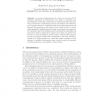Free Online Productivity Tools
i2Speak
i2Symbol
i2OCR
iTex2Img
iWeb2Print
iWeb2Shot
i2Type
iPdf2Split
iPdf2Merge
i2Bopomofo
i2Arabic
i2Style
i2Image
i2PDF
iLatex2Rtf
Sci2ools
RECOMB
2009
Springer
2009
Springer
Counting All DCJ Sorting Scenarios
In genome rearrangements, the double cut and join (DCJ) operation, introduced by Yancopoulos et al., allows to represent most rearrangement events that could happen in multichromosomal genomes, such as inversions, translocations, fusions and fissions. No restriction on the genome structure considering linear and circular chromosomes is imposed. An advantage of this general model is that it leads to considerable algorithmic simplifications. Recently several works concerning the DCJ operation have been published, and in particular an algorithm was proposed to find an optimal DCJ sequence for sorting one genome into another one. Here we study the solution space of this problem and give an easy to compute formula that corresponds to the exact number of optimal DCJ sorting sequences to a particular subset of instances of the problem. In addition, this formula is also a lower bound to the number of sorting sequences to any instance of the problem.
| Added | 20 May 2010 |
| Updated | 20 May 2010 |
| Type | Conference |
| Year | 2009 |
| Where | RECOMB |
| Authors | Marília D. V. Braga, Jens Stoye |
Comments (0)

